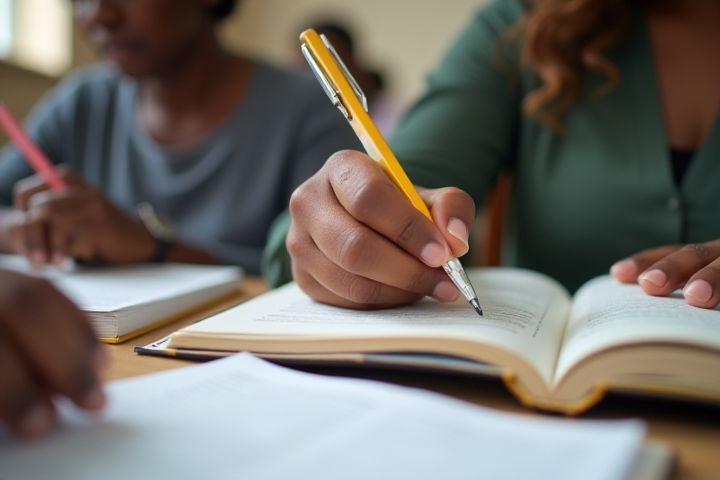
Nigeria has a literacy rate of approximately 62%, with significant regional disparities between the northern and southern regions. The country's educational system faces challenges such as inadequate resources, limited access to schools, and cultural factors that affect enrollment, particularly for girls. Various initiatives, including government programs and non-governmental organizations, aim to improve literacy through community-based education and adult learning initiatives. Urban areas generally report higher literacy rates compared to rural locations, where access to education remains a persistent challenge. For you, understanding these dynamics is crucial if you're considering educational projects or investments in Nigeria.
Regional disparities
Literacy rates in Nigeria reveal significant regional disparities, with the northern states experiencing lower levels of education compared to their southern counterparts. In the northeast region, factors such as poverty, cultural norms, and insurgency contribute to an average literacy rate of around 31.5%, contrasting sharply with the southern states, where rates can exceed 80%. These differences underscore the impact of socioeconomic conditions and access to educational resources, highlighting the urgent need for targeted interventions. Improving literacy in Nigeria requires addressing these regional barriers and fostering inclusive educational policies that cater to the unique challenges faced by each region.
Gender gap
In Nigeria, the literacy rates reveal a significant gender gap, with female literacy lagging behind male literacy in many regions. According to recent statistics, while approximately 62% of Nigerian men are literate, only around 50% of women achieve this benchmark, reflecting deep-rooted socio-cultural factors. This disparity is particularly pronounced in northern states, where traditional practices often prioritize boys' education over girls'. Efforts to bridge this gap are ongoing, with targeted initiatives promoting female education and raising awareness about the importance of equal access to learning opportunities.
Impact of poverty
Literacy rates in Nigeria are significantly influenced by poverty, with low-income households facing barriers to education access. Children from impoverished backgrounds often lack basic resources such as books, proper school facilities, and qualified teachers, which hinders their learning opportunities. Rural areas, in particular, experience a stark contrast in educational access compared to urban centers, exacerbating the literacy gap. Improving literacy rates in Nigeria requires targeted initiatives addressing both educational infrastructure and economic support for disadvantaged communities.
Urban vs rural differences
Literacy rates in Nigeria reveal a significant disparity between urban and rural areas, with urban regions typically exhibiting higher levels of education. For instance, cities like Lagos and Abuja boast literacy rates above 90%, while many rural communities struggle with rates as low as 50%. Factors contributing to this gap include access to quality schools, socioeconomic conditions, and cultural attitudes toward education. Understanding these differences is crucial for policymakers aiming to implement effective education reforms and improve overall literacy in Nigeria.
Education policies
Nigeria's literacy rates are significantly influenced by the nation's education policies, which aim to promote accessible and quality learning for all citizens. The government has implemented various initiatives, such as the Universal Basic Education Program, to enhance enrollment and retention in schools, particularly in rural areas. Despite these efforts, challenges such as inadequate infrastructure, teacher shortages, and cultural barriers persist, hindering overall literacy improvement. Your engagement with community-based programs can play a crucial role in supporting educational advancement and promoting lifelong learning in Nigeria.
Adult literacy programs
Nigeria's adult literacy programs aim to enhance the educational skills of its population, addressing the significant gap in literacy across various regions. These initiatives, often implemented by government agencies and non-governmental organizations, emphasize practical skills and vocational training alongside basic reading and writing. By targeting marginalized communities, such as women and rural populations, the programs strive to promote social inclusion and economic empowerment. Improving literacy rates is essential for fostering a more informed citizenry, ultimately driving national development and progress.
Language barriers
Literacy rates in Nigeria are significantly affected by various language barriers, as the country boasts over 500 indigenous languages. This linguistic diversity creates challenges in education, with many students receiving instruction in a language different from their native tongue, which can hinder comprehension and retention. Furthermore, the disparity in access to quality educational resources exacerbates the issue, particularly in rural areas where materials are often limited to major languages like Hausa, Yoruba, and Igbo. Understanding these language barriers is essential for developing effective literacy programs tailored to the unique linguistic landscape of Nigeria, ultimately helping to improve educational outcomes.
Access to education
In Nigeria, literacy rates highlight significant disparities in access to education across various regions and demographics. Over 50 million adults are illiterate, with northern Nigeria experiencing particularly low rates due to socio-economic and cultural barriers. Efforts to improve access include government initiatives and NGO programs aimed at promoting free primary education and adult literacy classes. Understanding these factors is crucial for implementing effective educational policies that cater to the diverse needs of Nigeria's population.
Impact of technology
In Nigeria, the impact of technology on literacy rates has been profound, as digital tools enhance access to educational resources. E-learning platforms and mobile applications have risen in popularity, allowing individuals to engage with learning materials anytime and anywhere. Moreover, initiatives like the National Open University of Nigeria leverage technology to provide quality education to remote areas, bridging the educational gap. As a result, you can witness a gradual improvement in literacy levels, empowering more citizens with essential skills for the 21st-century economy.
Government initiatives
In Nigeria, government initiatives play a crucial role in improving literacy rates, particularly among youth and marginalized communities. Programs like the Universal Basic Education (UBE) aim to provide free and compulsory education, addressing barriers such as poverty and access to resources. Collaboration with international organizations further enhances these efforts, facilitating teacher training and the development of educational materials. As you engage with these initiatives, it's essential to understand their impact on both individual and national growth.
